10 Facts You Should Know About Plantains
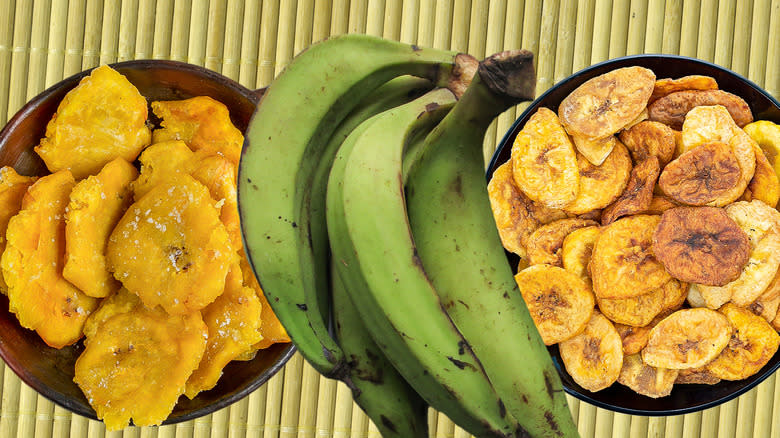
If you are an adventurous home cook who likes to try out new and unusual ingredients, it's likely that plantains have crossed your radar at some point. Easily mistaken for bananas, this starchy food is technically a fruit, but its flavor makes it more suited to savory dishes most of the time.
Plantains may not be widely used in the States — though they have been gaining popularity recently — but they are a staple ingredient in many cuisines across the world, including in Western Africa and the Caribbean. Their versatility and delicious flavor have long been enjoyed in these regions, where they feature in many local dishes.
If you're planning to give plantains a try, you may be wondering about the best ways to cook them, what color your plantains should be when they are ready for eating, or if they are going to make your dishes taste of banana. Join us for the answers to all of these questions and more, as we explore interesting facts about plantains. From their nutritional profile to their geographical origins, we will unearth everything you could possibly want to know about this wonderful fruit.
Read more: 13 Simple Tricks To Pick The Best Fresh Fruit Every Time
Plantains And Bananas Are Closely Related
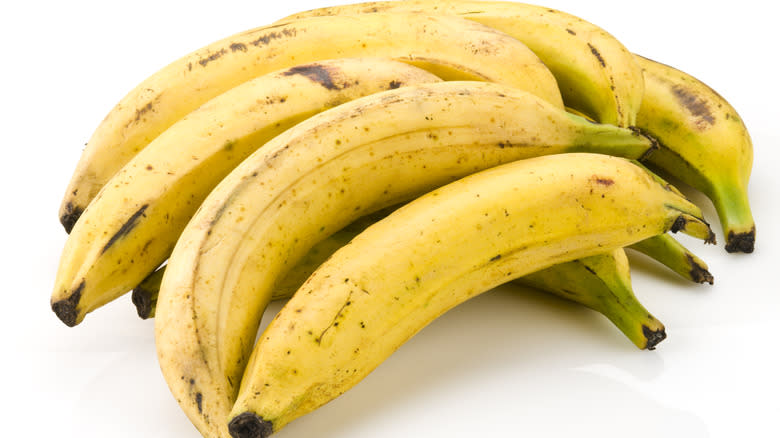
If you walk past plantains in the grocery store, you would be forgiven for mistaking them for bananas. Visually they are very similar, with bright yellow skins and elongated shapes. They belong to the same family of plants, musaceae, though there is quite a distinct difference in flavor between the two.
Evidence indicates that both bananas and plantains originated around Southeast Asia, but bananas are now grown in many sunny regions of the world, including India, Brazil, and the Philippines, while plantains are primarily popular in Africa, Central America, and the Caribbean. Plantains are the starchy cousins of bananas, and don't share a sweet flavor when underripe — however, a very ripe plantain can be soft and sweet, too. Plantains are generally bigger and have a tougher skin than bananas, and a knife is usually required to reveal the flesh inside.
The biggest difference between bananas and plantains is how they are prepared. In order to enjoy plantains at their best, they need to be cooked first, rather than eaten raw like bananas. This means that plantains should occupy a similar place in your cooking plans as yams or potatoes, needing to be prepared and cooked as part of a meal, rather than enjoyed as a ready-to-eat snack. But the next time you mistakenly grab a plantain instead of a banana at the supermarket, don't put it back. Treat it as an opportunity to explore a versatile ingredient, and see what it has to offer.
Plantains Can Be Eaten At Various Stages Of Ripeness
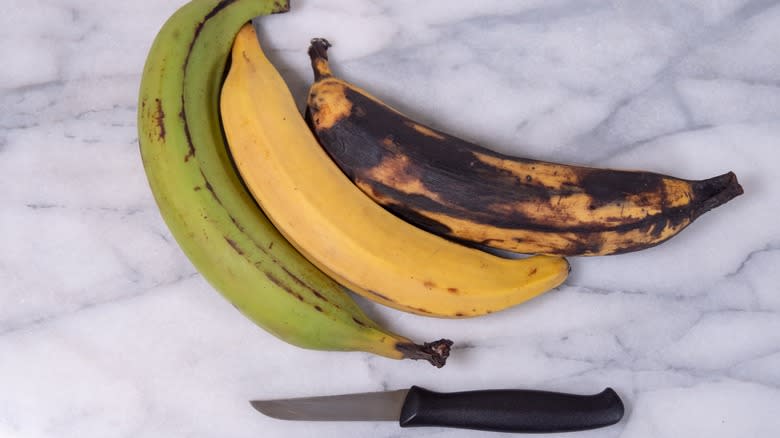
In a similar way to bananas, plantains go through distinct stages of ripeness. Initially they are a bright green color, and the flesh is very firm. Then, as they begin to ripen, they turn a vibrant yellow with some dark spots as the flesh softens. Finally, they go completely black on the outside, but the flesh inside will be soft and sweet. The great thing about plantains is that different dishes can be made at each of these three stages, taking advantage of the tastes and textures of differing ripeness levels.
The best way to use unripe plantains is to fry them, providing the basis for tostones and garlic sauce. Tostones are the plantain-based version of potato chips, and are twice fried to make them extra crispy. After cutting them into 1-inch chunks, salt your plantains before they hit the frying oil, then sauté the fruit in the pan, smash the chunks flat, and fry them up again.
At the middle stage of ripening, when the skins are bright yellow, plantains are at the perfect point between savory and sweet. They are delicious when baked and stuffed with meat or vegetable fillings and topped with cheese. And at the end of ripening, maduros are an ideal way to use black plantains, frying the sweetest version of the fruit until crispy with a soft texture inside. These crunchy, sweet treats are perfect as a side dish with a sprinkle of salt to balance the plantains' sugar.
You Shouldn't Eat Plantains Raw
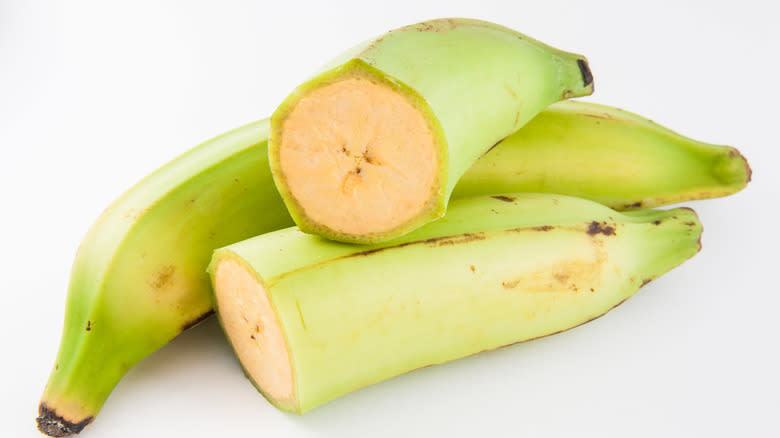
Though it may be tempting to treat plantains like bananas and simply peel and eat them, that is a mistake you are unlikely to make twice. Plantains are bitter and starchy when eaten raw, with a texture similar to raw potatoes. While you can technically eat them in this form, you would be missing out on the delicious caramelization that comes from cooking plantains and bringing out their sugars.
Ripe plantains in particular, with yellow or black skins, will have plenty of sugar that will caramelize beautifully as they are fried or roasted, creating that signature flavor that is the perfect balance of sweet and savory. They bring a lovely touch of sweetness to savory dishes, and can be roasted and served alongside meat or fish dishes in a manner similar to sweet potatoes. In the same way that a raw potato and a roasted potato have totally different flavors, raw plantain can't compare to the wonderful taste of a perfectly cooked version.
Cooking also softens the texture of plantains, especially if you bake them for a long time in the oven, removing the firm starchy texture and creating a delicious side dish or snack that has a pleasing mouthfeel. Roasting them is an easy way to transform raw plantains into a healthy and mouthwatering snack, all by simply slicing them into thin circles and allowing the oven to do the hard work.
Plantains Can Be Used In Sweet Or Savory Dishes
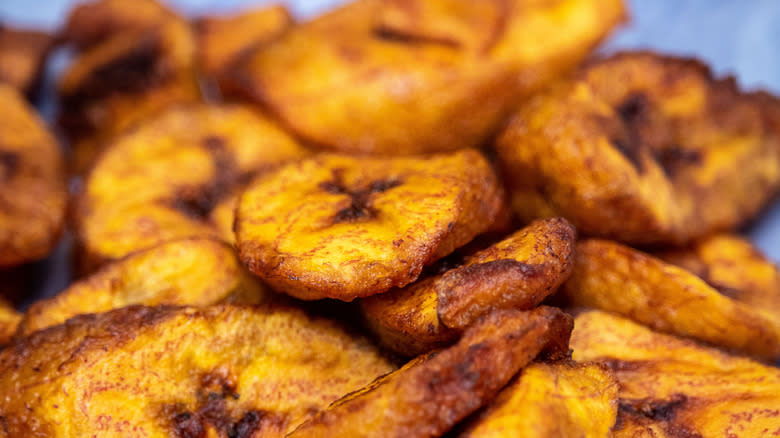
If plantains are not familiar to you as a home cook, it is worth getting to know them due to their incredible versatility. Sitting perfectly in the spot between sweet and savory means that plantains can be used in a huge variety of dishes, from savory side dishes to sweet and salty snacks, or even in desserts. While their more famous banana cousins take center stage in many desserts and cakes, they are rarely used in a savory dish, and this is where plantains can shine with their adaptability.
Plantains also make great savory pancakes, known as tatale. This African dish, popular in Ghana, combines plantains, onions, and plenty of aromatic spices, and is often served with beans. There are also the aforementioned tostones and maduros, both consisting of fried plantains, but differing in flavor and texture due to the ripeness of the fruit. Tostones are made with plantains that are still green and firm, while maduros utilize extremely sweet, ripe plantains with black skins.
If you want to harness the sweetness of plantains, you can turn them into a sugary treat that can be served as a dessert. Slicing plantains into discs before coating them in cinnamon and roasting them in the oven will bring out the naturally sweet flavor and create a decadent treat. They can then be served alongside other fruits and whipped cream to create a fresh and tasty dessert.
Plantains Likely Originated Around Southeast Asia
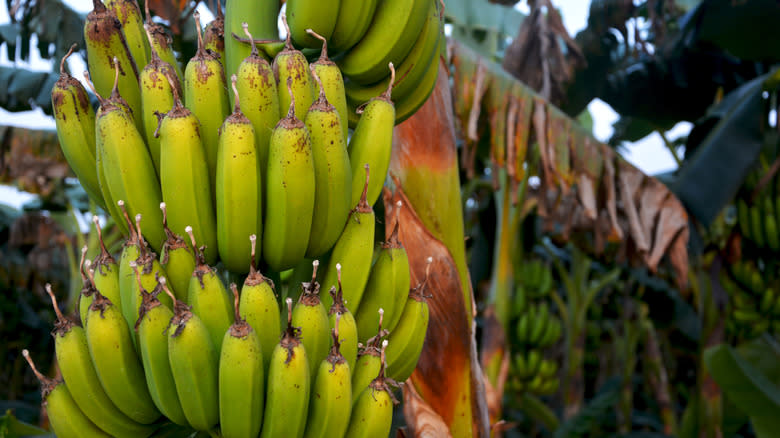
Plantains are well-known for being used in the cuisines of the Caribbean and parts of Africa, so you could be forgiven for thinking they are native plants in those regions. However, their journey most likely began on a Pacific island off Southeast Asia, and plantains have since traveled around the globe, finding a place in the hearts of many cultures along the way.
Researchers believe that plantains first grew on the island of New Guinea some 10,000 years ago. It's thought that over the following millennia, traders spread plantains along regions of the Indian Ocean coastline, where the hot climate of these tropical areas allowed this crop to flourish, and the fruit was widely embraced by locals. After the Age of Discovery dawned in the 15th century, seafarers from Spain and Portugal are credited with bringing plantains to the New World; some sources state that a Portuguese monk introduced this fruit to the Caribbean in 1516.
Nowadays, plantains are grown on multiple continents and have become an important part of numerous cuisines around the globe. From America to Asia, cultures from diverse parts of the world have put their own spin on this delicious fruit and made it their own. The rich history of the plantain, along with its incredible culinary versatility, only adds to its appeal.
Plantains Are Packed With Nutrition
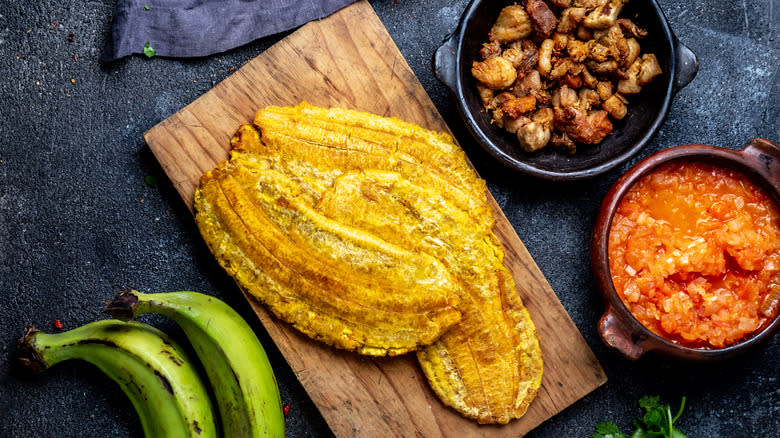
If you're thinking about adding plantains into your weekly meals, you will be pleased to know that as well as being versatile and delicious, they also pack a hefty punch when it comes to nutrition. Plantains make a great substitute for potatoes and grains, as they are low in fat while providing plenty of important nutrients.
Plantains are a good source of vitamin C, an antioxidant that is crucial for a healthy immune system. It also aids the absorption of iron, helps your body to heal, and contributes to healthy skin. Many of us think only of citrus fruits as sources for vitamin C, so it is great to know that plantains will allow you to up your intake as a side dish to your main course. They also contain vitamin A, a nutrient that is crucial to get from food as your body can't create it. Vitamin A plays an important part in keeping your eyes healthy, as well as protecting your body from infection and nourishing the skin.
Like bananas, plantains are high in potassium, an important mineral that may lower the risk of stroke or heart attack. Low potassium levels can cause you to feel weak, and adversely affect your heart rhythm. In addition to the various vitamins and minerals that plantains provide, it is also a great source of fiber, which helps your digestive system and makes you feel full after eating.
There Are Many Ways To Cook Plantains
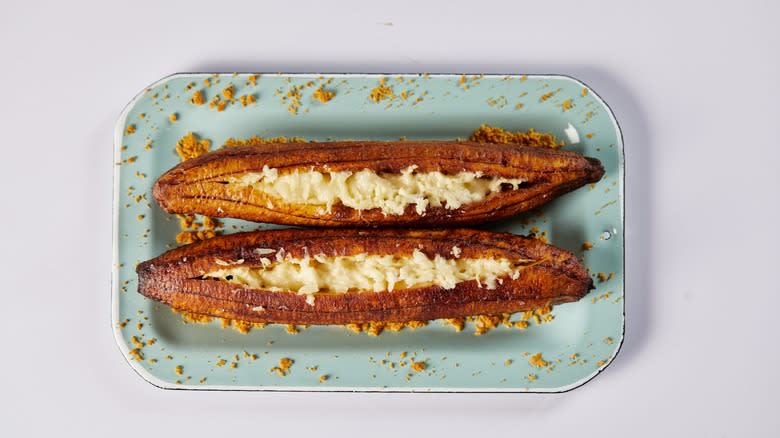
The ability of plantains to go with both savory and sweet dishes is one of the aspects that make them so versatile, but the fruit can also be cooked in a number of different ways, depending on what you are serving it with. How you cook plantains will affect their flavor, as a longer cooking time generally brings out more sweetness.
One of the easiest and quickest ways to cook plantains is to pan-fry them. Fried plantains make a great snack or side dish to a main course, and can take less than 15 minutes to cook. Simply cut ripe plantain into slices, sprinkle them with some sea salt, and add them to a pan with hot oil.
To further develop the sugars in the plantain, you can try roasting the fruit. In Nigeria, plantains are roasted on an open flame and served as a street food known as boli. You can recreate this at home by slicing ripe plantains in half, then baking them in the oven at 400 F with a little oil and salt for around 40 minutes, checking on them toward the end to prevent them from burning.
The fruit can also be boiled or fried and then mashed, as is the case with mofongo, Puerto Rico's classic plantain dish. Whatever way to you choose to prepare your plantains, they will provide a filling and delicious accompaniment to your dish.
Plantain Flour Can Be Used For Gluten-Free Baking
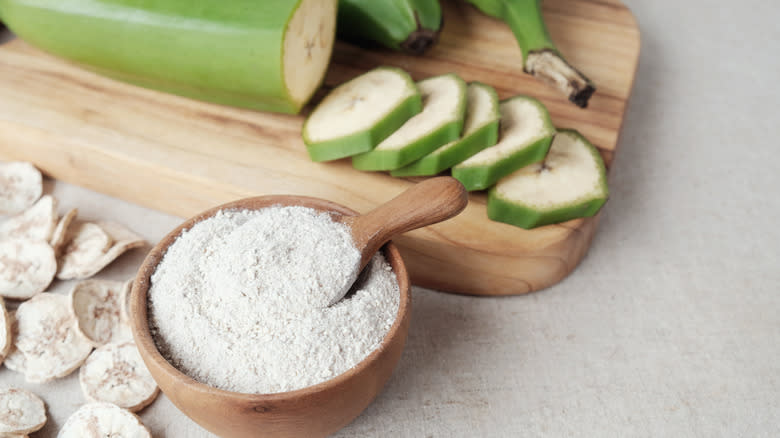
In the world of gluten-free flours, there are plentiful options to choose from. Almond flour, coconut flour, and rice flour are all widely available in grocery stores, giving those who wish to bake without gluten a variety of tasty alternatives. But one flour that you have likely not considered is plantain flour, which is the underrated gluten-free flour you should consider using. Made from unripe green plantains, the flavor of this flour is fairly neutral with a hint of nuttiness, and it will not make your baked goods taste of fruit.
Due to its high starch content, plantain flour can be used as a direct substitute for other flours in some recipes, though it can also produce baked goods that are denser than you would normally expect. For this reason, when making breads you may wish to mix a smaller proportion of plantain flour with another flour that you are more familiar with, to keep the texture light.
You could try making your own plantain flour from scratch if you have a dehydrator, or you can turn your oven to a very low heat setting and bake the sliced fruit for about four hours before grinding it. Whether you buy it from the store or make your own, plantain flour provides a great gluten-free way to switch up your baked goods while taking advantage of the fruit's many health benefits.
Plantains Are A Staple In The Caribbean

If you have spent time in the Caribbean, you have likely encountered plantains before. This fruit that acts as a vegetable is a staple part of the cuisines enjoyed by varied Caribbean cultures, and features in many traditional dishes.
Plantains have a long history in the Caribbean, where a Portuguese monk reportedly first brought the fruit to Santo Domingo, the Dominican Republic's capital city. As a filling and tasty food, plantains quickly became a popular addition to Caribbean dishes, used in numerous ways due to their versatility.
Nowadays, plantains play a key role in the hearty meal that is a traditional breakfast in the Dominican Republic, where this fruit began its Caribbean adventure. Mangú tres golpes consists of mashed plantains that are served with onions, meat, and eggs. This filling Dominican breakfast is a delicious way to start the day, and the starch in the plantains will fill you up and reduce the need for a mid-morning snack.
Plantains are used in Caribbean-style vegetable curries alongside beans and other veggies, soaking up the delicious flavors and making the meal more filling. Of course, sometimes it's best to keep things simple, and fried plantains are just as popular in Caribbean cuisine as they are elsewhere in the world. Whether making tostones from unripe green plantains or maduros from sweet ripe ones, fried plantains make a great snack or side dish enjoyed across the Caribbean archipelago.
There Are Two Main Varieties Of Plantain
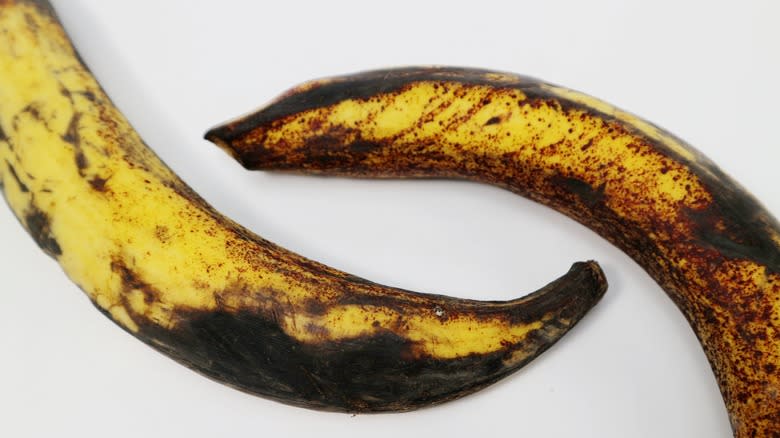
If you are shopping for plantains — once you have established that they are definitely not bananas, and know what ripeness level you are looking for — the last step is to work out which variety of plantain you need. Fortunately, there are only two types of plantain to choose from, so this shouldn't be too difficult a task.
The two most common varieties of plantain grown today are called French and horn. The French plantain grows in large bunches, and is widely grown in Asia, Latin America, and Africa, as well as on Pacific islands.
Horn plantains grow in smaller bunches that bear fewer fruits than the French variety. When very ripe, horn plantains can be used in sweet dishes with added sugar or cinnamon. Although there are differences between these two varieties, if you are only able to get your hands on one type of plantain, it should still be suitable to use in most dishes. Both varieties have the same fundamental flavor, and can be used in numerous sweet and savory recipes. But remember to pay attention to the color of the plantain skin, as the ripeness of the fruit can affect its texture and flavor regardless of which variety it belongs to.
Read the original article on Tasting Table


